Weekly Summary--Week 3 (03/07/20)
The book: finally back on track!
Last week we moaned and mourned the stupefying lack of progress in the book we were writing. Things were truly grim for the home team! We wrote, "In the two weeks here, we've only managed to write one page!"
Whether it be desperation or writer's block unblocked, this week the creative juices began to flow and finally writing happened.
So did photography!
The book: getting the pics
We have hundreds of sea turtle photographs from fifteen summers of diving with turtles. It became clear however, when writing the text, that we had photographic "holes" in our book.
We needed human-turtle shots. Shallow shots-of sea turtles feeding. Shots of snorkelers with sea turtles. Dry sea turtles (all our shots are of wet sea turtles). We needed photographs that could not be had on Maui.
So we endured the assault on human dignity that has become airline travel and went to Oahu for a two day Photo MegaShoot. We spent most of those two days at one beach to try and get the necessary pics.
We also hoped with a combination of shooting and shooting and then shooting some more, we'd luck out and get "the (pronounced thee) photo".
We had it. We lost it. Somehow. Inexplicably. It got deleted from our digital camera. Worse, we found we could recover every other deleted photo but the magic one. No bigger fish ever got away.
No more important bomb ever squirted from between eager mitts.
No fickler finger-of-fate ever fingered photographers.
No--sigh--Time to move forward. Failing forward, at least move on...
Laniakea photos
We now have kid-sea turtle photos.
62K JPEG
|
|
|
|
We have people-snorkeling-with-sea-turtle photos.
62K JPEG
|
We've got shallow-feeding photos.
54K JPEG
|
|
|
|
Then there are turtles-feeding-out-of-the-water photos.
62K JPEG
|
Not to mention dry-sea-turtle photos.
63K JPEG
|
|
We still have "holes", mind you, but the pit is getting smaller as we fill it up.
Closer to home, the Honokowai ohana: more bad news
When we first sighted Akebono in 1999 she was the teeniest turtle we'd ever seen. Every summer since she'd peer at us from her underwater ledge at The Cavern. We called her Akebono in the hopes that this name may afford her protection and good luck. We hoped "Akebono" would grow to be as big as the real Akebono and be spared the fate of other juveniles living at Honokowai.
Most little turtles here develop fibropapilloma and then "disappear".
It didn't take long for us to notice that Akebono's eyes were showing the white milky banding that we've come to recognize as harbingers of the disease. Ocular white banding leads to swelling. In our experience, the swelling eventually erupts into "hot spots" and then erupts into true fibropapilloma tumors.
Last summer Akebono showed a tiny tumor in her right eye. She had several whitish bumps on her shoulder that we regarded with considerable concern.
Here is what Akebono looked like at the end of August 2002.
For her 2002 summer entry we wrote:
"We believe that in 2003 Akebono will have true tumors. While the pre-eruptive stage has taken almost three summers--comparatively slow progress considering that Akebono is a juvenile--we don't believe she'll be as lucky next summer.
"We fear that in 2003, she'll be watching us through ocular tumors, simply because that's the course of this disease."
We sighted her for the first time this summer. Akebono swam up to us and her sad state confirmed our gravest fears.
Her sad state confirmed our gravest fears.
51K JPEG
|
|
Akebono has followed the identical FP path as her cohort Makana: gone from barely noticeable bumps one summer to numerous eye and body tumors in under 11 months.
We don't expect to see Akebono in 2004. Like Makana before her, Akebono becomes the newest juvenile FP victim.
 Turtle Happenings
Turtle Happenings
Last modified 03/07/26
Send comments or corrections to webmaster@turtles.org
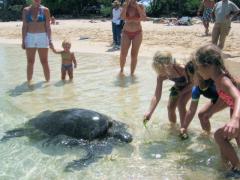
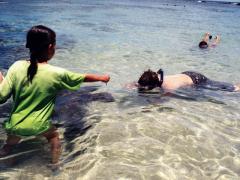
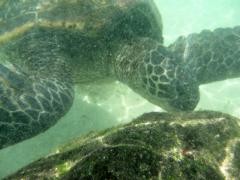
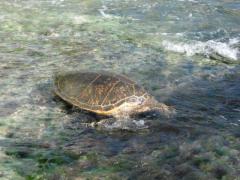
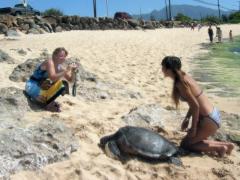
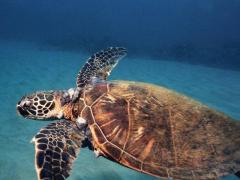
 Turtle Happenings
Turtle Happenings